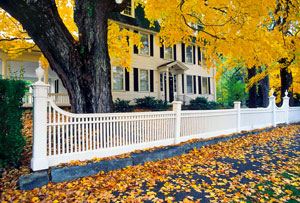 Fall is the perfect time to help your trees recover from the heat and lack of water they probably experienced over the summer. Stressed trees are more susceptible to pests, disease, and winter damage so now’s the time to make sure your trees enter the harsh winter months in the best health possible.
Fall is the perfect time to help your trees recover from the heat and lack of water they probably experienced over the summer. Stressed trees are more susceptible to pests, disease, and winter damage so now’s the time to make sure your trees enter the harsh winter months in the best health possible.
Below are the activities we recommend you do before the snow starts flying.
And don’t forget to download our Fall Tree Care Tips!
Water and Mulch Your Trees and Shrubs
- Give all of your trees and shrubs a good drink, especially those that were recently planted. Place a 2 to 3-inch layer of high-quality, organic mulch around young trees and plants. Mulch helps keep organic matter in the soil around the tree, conserves soil moisture, and provides weed control. Don’t over-mulch! For tips on how to do it right, see our article on Mulching Trees.
Clean Up
- Remove fallen leaves from beneath trees and shrubs that are susceptible to diseases such as anthracnose, fire blight, and cedar apple rust. Leaving the leaves on the ground over winter will spread the disease and weaken your trees. Be especially vigilant around trees such as dogwoods and crabapples.
- For leaves that aren’t prone to disease, consider mulching them in place or turning them into leaf compost rather than disposing of them. Check out our article on what to do with fallen leaves.
Evaluate Trees for Weaknesses
- Evaluate trees for weaknesses that can be susceptible to winter weather. Contain heavy ends on limbs too long to support snow and ice loads. Install temporary or permanent rope, cable or twine in plants (multi-stem) susceptible to snow and ice loads (do not forget to remove temporary support in the spring).
- After the leaves have fallen you’ll be better able to see the branch structure and condition of your trees. If anything looks unsafe (see our article on Identifying Hazardous Trees), give us a call. Fall is the best time to prune, remove, or cable your tree to protect you and your property over the winter.
Protect Trees and Shrubs
- Protect plants susceptible to winter injury by spraying them with anti-desiccants or covering with a breathable burlap type material. You can learn more about using burlap to protect your plants in our article on How to Protect Trees and Shrubs From Winter Weather.
Check for Deer Damage
- Check deer susceptible plants for evidence of grazing. Look for things like thinning of a plant’s foliage at the 5 ft level and below (deer head height) or droppings near preferred plants. If you notice deer damage, fall is the best time to spray deer repellent that will protect your trees over the winter. For more information, check out our article on How to Prevent Winter Deer Damage.
Plant New Trees
- Fall is a great time to plant new trees and shrubs. The ground is still warm (so plant before the frost starts freezing the soil!) and there’s plenty of moisture, both of which will get your plants off to a quick start. For more details and some planting tips, see Fall is Ideal Tree Planting Time. You might also want to choose one of our recommended 10 Best Trees for Fall Foliage Color in CT.



